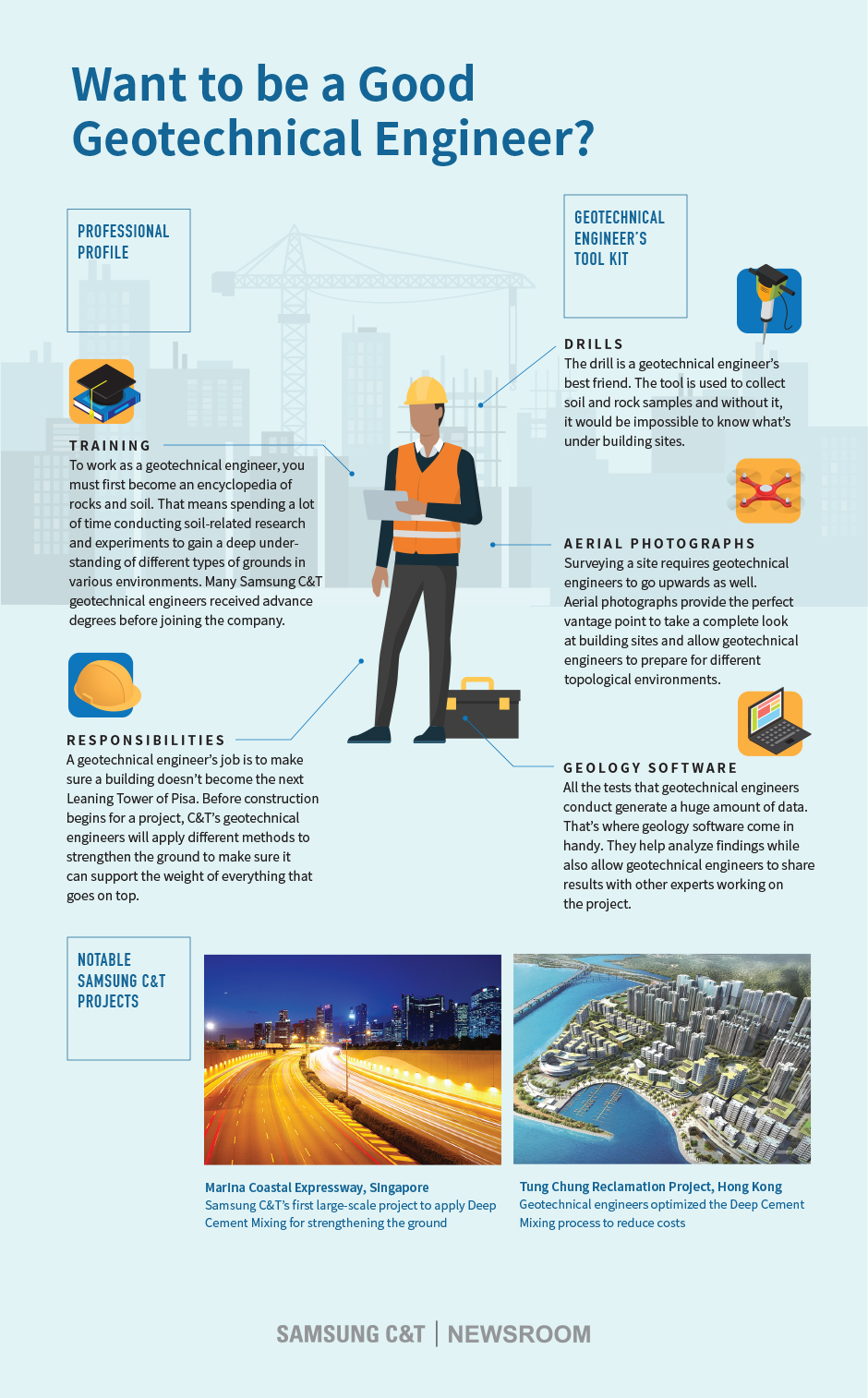The 10-Minute Rule for Geotheta
The 10-Minute Rule for Geotheta
Blog Article
The smart Trick of Geotheta That Nobody is Talking About
Table of ContentsGeotheta Fundamentals ExplainedGeotheta - The FactsNot known Facts About GeothetaGeotheta - TruthsThe Buzz on Geotheta

They perform site examinations, accumulate samples, perform research laboratory examinations, and evaluate data to examine the viability of the ground for construction tasks - Consulting Engineers. Based on their searchings for, geotechnical designers provide referrals for structure design, slope security, keeping structures, and reduction of geotechnical dangers. They work together with other professionals, such as engineers, architectural designers, and building and construction teams, to make certain that geotechnical factors to consider are integrated into the overall project layout and execution
By assessing the behavior and properties of dirt and rock, they can recognize potential geotechnical hazards such as landslides, dirt negotiation, or incline instability. Their expertise helps protect against failings or crashes that can threaten lives and residential property. Here are some thorough responsibilities and responsibilities of a geotechnical engineer: Site Investigation: Geotechnical engineers conduct site investigations to gather data on subsurface conditions.
They translate the information to recognize the residential properties and behavior of the soil and rock, including their strength, leaks in the structure, compaction features, and groundwater conditions. Geotechnical Evaluation and Design: Geotechnical designers examine the data gathered throughout site examinations to analyze the stability and suitability of the site for construction jobs. They do geotechnical estimations and modeling to assess variables such as bearing capability, settlement, incline stability, lateral planet pressures, and groundwater circulation.
An Unbiased View of Geotheta
Structure Style: Geotechnical designers play a crucial role in making foundations that can safely support the desired framework. They assess the soil conditions and lots requirements to figure out the suitable foundation kind, such as shallow structures (e.g., footings), deep foundations (e.g (https://dzone.com/users/5183482/geotheta.html)., piles), or specialized techniques like dirt enhancement. They take into consideration factors such as negotiation limits, birthing capability, and soil-structure interaction to develop ideal structure layouts
They examine building and construction strategies, display website tasks, and conduct field assessments to confirm that the style recommendations are adhered to. If unexpected geotechnical problems develop, they examine the circumstance and provide recommendations for removal or adjustments to the layout. Threat Assessment and Reduction: Geotechnical designers analyze geotechnical dangers and dangers connected with the job site, such as landslides, liquefaction, or soil erosion.

Cooperation and Interaction: Geotechnical designers function carefully with various other professionals associated with a job, such as designers, architectural engineers, and construction groups. Reliable communication and collaboration are important to incorporate geotechnical considerations into the overall task style and building and construction process. Geotechnical engineers provide technological competence, answer inquiries, and guarantee that geotechnical needs are satisfied.
The smart Trick of Geotheta That Nobody is Discussing
Here are some types of geotechnical designers: Foundation Engineer: Foundation engineers concentrate on designing and evaluating structures for structures. They examine the dirt conditions, load needs, and site characteristics to figure out one of the most suitable structure type and design, such as shallow structures, deep foundations, or specialized techniques like pile structures.
They examine the aspects influencing slope stability, such as dirt properties, groundwater problems, and incline geometry, and develop methods to stop slope failings and reduce dangers. Quake Engineer: Earthquake designers concentrate on examining and creating structures to hold up against seismic pressures. They analyze the seismic danger of a website, evaluate dirt liquefaction capacity, and develop seismic design standards to make sure the security and resilience of structures during earthquakes.
They execute area testing, collect samples, and examine the collected information to identify the dirt residential properties, geologic developments, and groundwater conditions at a site. Geotechnical Instrumentation Designer: Geotechnical instrumentation designers concentrate on surveillance and measuring the actions of soil, rock, and structures. They install and preserve instrumentation systems that monitor elements such as soil negotiation, groundwater degrees, incline motions, and structural variations to examine performance and give very early cautions of prospective concerns.
Geotheta Can Be Fun For Everyone
They carry out tests such as triaxial tests, combination examinations, direct shear tests, and leaks in the structure examinations to gather data for geotechnical evaluation and design. Geosynthetics Designer: Geosynthetics engineers concentrate on the style and application of geosynthetic materials, such as geotextiles, geogrids, and geomembranes. They utilize these products to boost soil stability, strengthen slopes, offer drain services, and control disintegration.
They often tend to be investigatory individuals, which indicates they're intellectual, introspective, and investigative. They wonder, systematic, reasonable, analytical, and rational. Several of them are likewise social, indicating they're kind, charitable, cooperative, patient, caring, helpful, compassionate, sensible, and friendly. Does this seem like you? Take our free occupation test to learn if geotechnical designer is among your top job suits.
In the office setting, geotechnical engineers utilize specialized software devices to carry out computations, produce styles, and examine data. They prepare records, evaluation job requirements, Extra resources interact with clients and team participants, and coordinate project activities. The office setup offers a conducive environment for study, analysis, and collaboration with other professionals included in the job.
Geotheta Can Be Fun For Everyone
They frequently visit task websites to carry out website investigations, evaluate geotechnical conditions, and collect information for analysis. These check outs involve traveling to different places, often in remote or tough surfaces. Geotechnical engineers may carry out dirt tasting, conduct examinations, and display construction activities to make sure that the geotechnical elements of the job are being carried out appropriately.
Geotechnical designers also operate in specialized geotechnical labs. In these facilities, they carry out experiments, execute examinations on dirt and rock samples, and examine the engineering residential properties of the materials. Geotechnical laboratory designers work extensively in these atmospheres, handling screening tools, operating tools, and tape-recording information. They work together with other lab staff to ensure exact and trustworthy testing outcomes.
Report this page